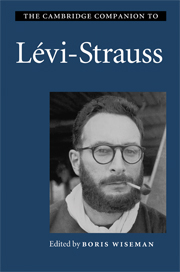Book contents
- Frontmatter
- Introduction
- Part I: Society and culture
- Part II: Myth and mind
- Part III: Language and alterity
- Part IV: Literature and aesthetics
- 13 Structuralism, poetry, music: Lévi-Strauss between Mallarmé and Wagner
- 14 Morphology and structural aesthetics: from Goethe to Lévi-Strauss
- 15 Structure and sensation
- Bibliography of works by Claude Lévi-Strauss
- Index
14 - Morphology and structural aesthetics: from Goethe to Lévi-Strauss
from Part IV: - Literature and aesthetics
Published online by Cambridge University Press: 28 January 2010
- Frontmatter
- Introduction
- Part I: Society and culture
- Part II: Myth and mind
- Part III: Language and alterity
- Part IV: Literature and aesthetics
- 13 Structuralism, poetry, music: Lévi-Strauss between Mallarmé and Wagner
- 14 Morphology and structural aesthetics: from Goethe to Lévi-Strauss
- 15 Structure and sensation
- Bibliography of works by Claude Lévi-Strauss
- Index
Summary
In a 1999 article written as a tribute to Claude Lévi-Strauss for a special issue of the French journal Critique, I surveyed Lévi-Strauss's references to Goethe, and this led me to refine the thesis that - as I had already argued in the mid-seventies with regard to René Thom's morphodynamic structuralism - there exists an authentic morphological genealogy of structuralism in the history of ideas.
This is the thesis that I will develop in the present essay, taking as an example a pictorial analysis from Lévi-Strauss's Look, Listen, Read (1997). This will enable me to revisit the teachings of a thinker who has left an indelible mark on my intellectual life.
The morphological genealogy of structuralism in Claude Lévi-Strauss
In his presentation of the aims of this Cambridge Companion, Boris Wiseman recalls Claude Lévi-Strauss's assertion that there were only three structuralists in France: Dumézil, Benvéniste and himself (by the way, for Roman Jakobson there were only five structuralists in the world: Saussure, Prince Troubetskoi, Lévi-Strauss, Thom and himself), and he interprets this as a warning against the temptation to dissolve Lévi-Strauss's thinking in the homogeneous cloud 'structuralism'.
Boris Wiseman's remark is well founded. Lévi-Strauss often quite rightly set himself apart from the school of thought which Parisian intellectuals called 'structuralism' before they moved on to 'post-structuralism'. For instance, in his conversation with Didier Eribon (1991b), he drily criticises the 'ridiculous' excesses of the structuralist 'vogue' among the intelligentsia, upbraiding several of his colleagues.
- Type
- Chapter
- Information
- The Cambridge Companion to Lévi-Strauss , pp. 275 - 295Publisher: Cambridge University PressPrint publication year: 2009
- 6
- Cited by



